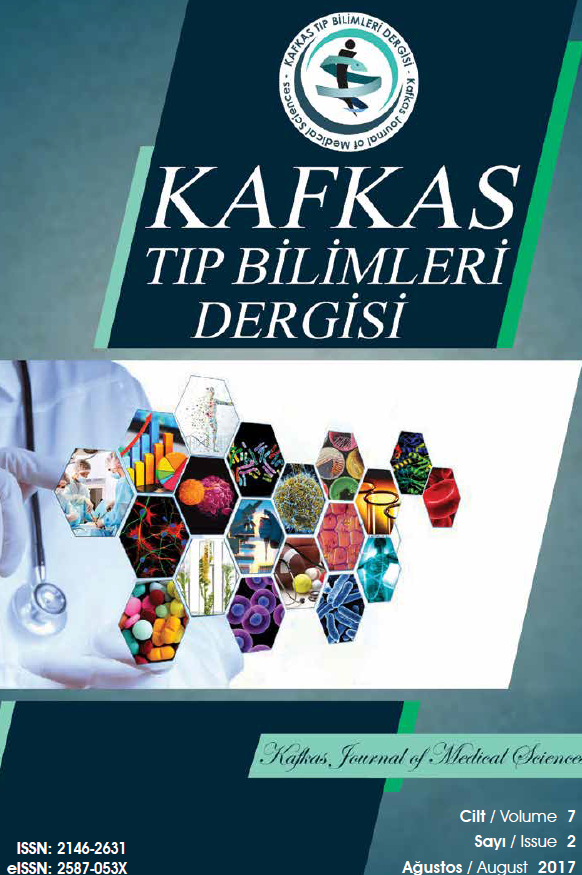Kronik Otitis Media ve Alerjik Rinit Arasındaki İlişkinin Değerlendirilmesi
Alerjik rinit, SFAR, kronik süpüratif otitis media, etyoloji, prevalans
Evaluation of the relationship between chronic otitis media and allergic rhinitis
Allergic rhinitis, SFAR, chronic suppurative otitis media, etiology, prevalance,
___
- 1. Akyıldız, A.N. : Kulak Hastalıkları ve Mikrocerrahisi. Ankara, Bilimsel Tıp Yayınevi, 1998, pp. 86,337,373.
- 2. Humaid AH, Ashraf AH, Masood KA, Nuha AH, Saleh AD, Awadh AM. Prevalence and risk factors of Otitis Media with effusion in school children in Qassim Region of SaudiArabia. Int J HealthSci (Qassim). 2014;8(4):325-34.
- 3. Nemati S, Shakib RJ, Shakiba M, Araghi N, Azimi SZ. Allergic rhinitis in adults with chronic suppurative otitis media. Iranian Journal of Otorhinolaryngology. Jul 2015; 27(4): 261-266.
- 4. Gorgulu O, Ozelci M, Ozdemir S, Yasar M, Olgun MK, Arikan OK. The role of allergy in the pathogenesis of chronic suppurative otitis media. Journal of International Advanced Otology . 2012, Vol. 8 Issue 2, p276-281. 6p.
- 5. Knight LC, Eccles R, Morris S. Seasonal allergic rhinitis and its effects on eustachian tube function and middle ear pressure. Clin Otolaryngol Allied Sci. 1992 Aug;17(4):308-12.
- 6. Bakhshaee M, Rajati M, Fereidouni M, Khadivi E, Varasteh A. Allergic rhinitis and chronic suppurative otitis media. Eur Arch Otorhinolaryngol. 2011 Jan; 268(1):87-91.
- 7. Fliss DM, Shoham I, Leiberman A, Dagan R. Chronic suppurative otitis media without cholesteatoma in children in southern Israel: incidence and risk factors. Pediatr Infect Dis J. 1991 Dec; 10(12): 895-9.
- 8. Heo KW, Kim MJ, Lee JH. Impact of nasal conditions on chronic otitis media: a cross-sectional study in Koreans. Acta Otolaryngol. 2018 Feb;138(2):116-121.
- 9. Park M, Lee JS, Lee JH, Oh SH, Park MK. Prevalence and risk factors of chronicotitis media: the korean national health and nutrition examination survey 2010–2012. PLoS One. 2015 May 15;10(5): e0125905.
- 10. Kim DH, Han K, Kim SW. Relationship Between Allergic Rhinitis and Mental Health in the General Korean Adult Population. Allergy Asthma Immunol Res. 2016 Jan; 8(1): 49–54.
- 11. Cingi C, Songu M, Ural A, Annesi-Maesano I, Erdogmus N, Bal C, et al. The Score For Allergic Rhinitis study in Turkey. Am J Rhinol Allergy 2011;25:333-7.
- 12. Shaheen MM, Nahar S. Comparison of chronic suppurative otitis media in rural and urban primary school children in Bangladesh. J Laryngol Otol. 2014 Jun; 128 (6):499-503.
- 13. World Health Organization. Chronic suppurative otitis media; burden of illness and management options. Geneva, Switzerland. World Health Organization. 2004; 2-83.
- 14. Guler Y, Ozdamar K, Erdim İ, Sen A, Guler R. Does breastfeeding protect from allergic rhinitis ?. Praxis of Otorhinolaryngology 2018; 6 (1): 17-21.
- 15. Steele RW, Suskind-Liu OL. Contemporary Diagnosis and Management of Otitis Media. Newton: Handbooks in Health Care Co.; 2000.
- 16. De Marco R, Cappa V, Accordini S, Rava M, Antonicelli L, Bortolami O et al. Trends in the prevalence of asthma and allergic rhinitis in Italy between 1991 and 2010. European Respiratory Journal 2012; 39: 883-892.
- 17. Lack G, Caulfield H, Penagos M. The link between otitis media with effusion and allergy: a potential role for intranasal corticosteroids. Pediatr Allergy Immunol 2011;22(3):258–66.
- 18. Simpson SA, Lewis R, van der Voort J, Butler CC. Oral or topical nasal steroids for hearing loss associated with otitis media with effusion in children. Cochrane Database Syst Rev. 2011 May 11;(5):CD001935.
- 19. Strachan DP. Hay fever, hygiene, and household size. BMJ. 1989;299:1259–1260.
- 20. Robinson DS. Th2 cytokines in allergic disease. Br Med Bull 2000; 56: 956-6.
- 21. Stirling RG, Chung FK. New immunologic approaches and cytokine targets in asthma and allergy. Eur Respir J 2000; 16: 1158-74.
- 22. Matricardi PM, Rosmini F, Rapicetta M, Gasbarrini G, Stroffolini T.Atopy, hygiene, and anthroposophic lifestyle. San Marino Study Group. Lancet 1999; 354: 43.
- ISSN: 2146-2631
- Yayın Aralığı: Yılda 3 Sayı
- Başlangıç: 2011
- Yayıncı: Kafkas Üniversitesi
Abdurrahman ÇETİN, Abdulkadir YEKTAŞ
Nazofarenks Punch Biyopsi Sonuçlarının Retrospektif Analizi
Selçuk GÜNEŞ, Mustafa ÇELİK, Burak OLGUN, İrem ÖZEN, Hüseyin Avni ULUSOY
Primer Sezaryen Sırasında Adneksial Torsiyon ve İnfundibulo-Pelvik Ligament Yokluğu: Vaka Sunumu
Gülten SAĞIR, Bakiye AKBAŞ, Özgür ÖZDEMİR
Türk Toplumunda Foramen Magnum ve Kafa Tabanındaki Oluşumların İlişkileri
Burcu Erçakmak GÜNEŞ, Alper VATANSEVER
Ayak Arkus Açısı ve Ayak Uzunluğu Arasındaki İlişki
Mesane Kanseri Nedeniyle Transüretral Rezeksiyon Yapılan 177 Olgunun Retrospektif Analizi
Erkan HİRİK, Mecdi Gürhan BALCI
Kronik Otitis Media ve Alerjik Rinit Arasındaki İlişkinin Değerlendirilmesi
Yavuz GÜLER, Rukiye GÜLER, Alper ŞEN, Kadir ÖZDAMAR, Esra AYCAN ÜSTYOL
Muhammed YAYLA, Damla ÇETİN, Çağlar DEMİRBAĞ, Pınar AKSU KILIÇLE
Genom Düzenlemede CRISPR/Cas9 Çağı ve Lösemideki Uygulamaları
